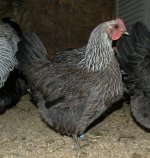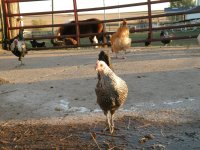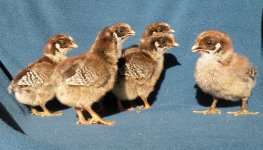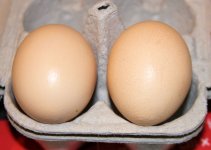Gordo 56
Silver Member

This is a post from my farm blog, thought some would enjoy it here.
While we are planning our pole barn house we are also deciding what animals we want to raise and what animals that are best suited for our land. We have decided we want to raise heritage breed animals that were raised in Europe and the United States before 1960. Heritage breeds are better foragers and hardy souls that will do well on their own. We knew we wanted to raise Scottish Highland Cattle, but we didn't know what chickens we wanted to raise until I was reading my March issue of Hobby Farm and came upon an article about raising chicken breeds best suited for your region. For the Midwest one of the breeds mentioned was the Iowa Blue Chickens. Until that article I had never heard of the Iowa Blue chicken, so I did some research and found the Iowa Blue Chicken Club and their website and found they had a lot of information about the Iowa Blue. I found it to be a fascinating breed with an interesting story that I wanted to share with my readers. In this post I plan to tell you the story about how this breed was developed and how they came back from the brink of extinction and why you might want to add this bird to your flock.

Iowa Blue Hen
The Iowa Blue is the only breed of chicken that was developed in Iowa and was first developed in the early 1900's around Decorah Iowa by a man named John Logston. This dual purpose breed was developed to be something more than just a meat and egg chicken. The small farms of its day needed chickens that could forage for most of their own food for most of the year and had to be able to reproduce and raise their young on their own without much help and be able to defend against and out smart predators. This breed could do those things and was sold by several hatcheries in the Northeast part of the state through the 1960's until the hatcheries went out of business. The hatcheries went out of business because small family farms were going out of business as the industrialized farming industry was taking hold. The average size farm went from 200 acres to over 400 acres and for the industry to be profitable they had to specialize in one or to crops or animals and not be as diversified as the smaller farms were. From 1950 to 1970 this country lost half it farms with 10 million people leaving the farm to move to the city. Back in 1900 98% of the farms in this country had chickens, by 1992 only 4% had them. This slower growing and self-sufficient breed and others like them did not appeal to the factory farms that specialized in chickens and were pushed aside for the faster growing and better laying hybrids and the Iowa Blue was nearly lost.
When this breed was first developed in the early 1900's most towns had their own small hatcheries and back then they didn't ship birds much. Most people came to the hatchery to pick up their chicks. So the Iowa Blue hadn't expanded much beyond the southeast part of the state. By the 1980's there were only two known flocks left in existence and if not for the efforts of one man and a small group of dedicated breeders this breed might have gone the way of 200 other heritage breeds of livestock that have gone extinct in the last two decades around the world.

A young Iowa Blue Hen
Ken Whealy of Decorah based Seed Saver Exchange heard about the Iowa Blue on a campout with other fellow group members and went to look for the breed at the family farm of Micheal Moore the grandson of John Logston the developer of the Iowa Blue. The grandson had taken over the family farm and had contuinued raising his grandfathers Dexter cattle and had many other chickens, ducks, geese, pheasants and hogs. He said he only had 6 Iowa Blues left, he had about 50 the year before but they had gotten in some bad oats and most had died and some hogs had killed a few. All that was left was one old rooster named Herman and 5 hens that hadn't had any eggs hatch in a few years. Michael was concerned for the breed and gave Ken the Rooster and the five hens to try and save the last of the Iowa Blues. The Rooster was too old and wasn't fertile anymore so he asked Mr. Moore if he knew of any one else who might still have a flock of Iowa Blues and he only knew of one other person. His grandmother Dolly Logston had sold a few to a man named Ransome Bolson by Northeast Decorah in the 1960's. Ransome did have a flock of about 50 birds and with these two known flocks of Iowa Blues they were able to save this bird from extinction.
How The Breed Was Developed
The folklore about the development of the breed is where this story gets interesting and was told by Mr. Logston's widow, Dolly. The development of this breed came about by accident. She said that a white Plymouth Rock hen went broody and went under a farm building to nest and came out with a clutch of chicks that were solid chestnut to stripes that no one had ever seen before, they looked like pheasants. They thought the chicks were sired by a pheasants.

You can see how the baby chicks look similar to young pheasants.
This would explain the color of the chicks and why the breed does so well foraging for itself and is said to be very hardy and well suited for the weather in Iowa with the very hot and humid summers and the very cold winters. The breed is an insect control champ and the roosters and hens are also great at self-defense according to Kari McKay-Waddel, Vice President of the Iowa Blue Chicken Club who raises Iowa Blues on her farm. She has said to have seen on several occasions the Iowa Blue defending itself successfully against several hawk attacks and other predators such as cats and opossums. The roosters get to about 7 pounds and the hens about 5 and they lay medium sized eggs that are brown to light cream in color.

Iowa Blue eggs
With people once again moving back to the country and starting small family farms the need for this kind of chicken is growing. The Iowa Blue is now making a come back thanks in part by the promotion of the Iowa Blue Chicken Club. If you would like to be part of the rescure effort of this bird and would like more information, please go to their website at Iowa Blue Chicken Club - Home
Last edited:
